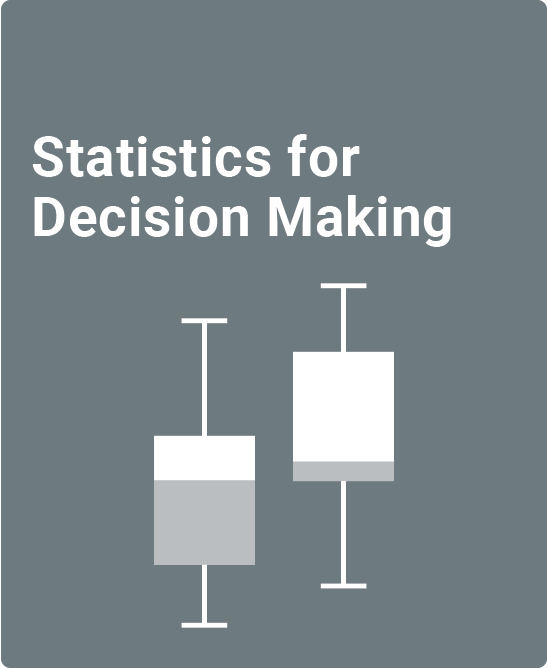Table of Contents
1. Descriptive Statistics
1.1 Statistics and the decision-making process
1.2 Collecting data
1.3 Understanding data
1.4 Data and spreadsheets
1.5 Introduction to data visualization
1.6 Bar charts
1.7 Measures of center
1.8 Histograms
1.9 Measures of variability
1.10 Relative measures
1.11 Box plots
1.12 Scatter plots
1.13 Line charts
1.14 Case study: Ten-year employment projections
2. Probability
2.1 Introduction to probability
2.2 Addition rule and complements
2.3 Multiplication rule and independence
2.4 Conditional probability
2.5 Bayes’ Theorem
2.6 Combinations and permutations
3. Discrete Probability Distributions
3.1 Introduction to random variables
3.2 Properties of discrete probability distributions
3.3 Binomial distribution
3.4 Poisson distribution
3.5 Hypergeometric distribution
4. Continuous Probability Distributions
4.1 Properties of continuous probability distributions
4.2 Normal distribution
4.3 Sampling distributions and the Central Limit Theorem
4.4 Student’s t-Distribution
4.5 F-distribution
4.6 Chi-square distribution
5. Confidence Intervals
5.1 Confidence intervals
5.2 Confidence intervals for population means
5.3 Confidence intervals for population proportions
5.4 Case study: Self-employment
6. Hypothesis Testing
6.1 Hypothesis testing
6.2 Hypothesis tests for a population mean
6.3 Hypothesis test for a population proportion
6.4 Hypothesis tests for the difference between two population means
6.5 Hypothesis test for the difference between two population proportions
6.6 One-way analysis of variance (one-way ANOVA)
6.7 Case study: Fluent company names
7. Linear Regression
7.1 Introduction to linear regression
7.2 Least squares method
7.3 Linear regression assumptions
7.4 Correlation and coefficient of determination
7.5 Interpreting fitted models
7.6 Confidence and prediction intervals
7.7 Testing linear regression parameters
7.8 Case study: Activity levels for parents and children
8. Multiple Linear Regression
8.1 Introduction to multiple regression
8.2 Multiple regression assumptions and diagnostics
8.3 Coefficient of multiple determination
8.4 Multicollinearity
8.5 Interpreting multiple regression models
8.6 Confidence and prediction intervals for MLR models
8.7 Testing multiple regression parameters
8.8 Case study: Cars
9. Chi-square Tests for Categorical Data
9.1 Categorical data
9.2 Fisher’s exact test
9.3 Introduction to chi-square tests
9.4 Chi-square test for homogeneity and independence
9.5 Case study: Flu Vaccines
10. Appendix A: Distribution Tables
10.1 t-distribution table
10.2 z-distribution table
10.3 Chi-squared distribution table
11. Appendix B: CSV Files
11.1 Data sets
12. Appendix C: Applets
12.1 Graphing and descriptive statistics
12.2 Discrete probability distributions
12.3 Continuous probability distributions
12.4 Sampling distributions
12.5 Hypothesis tests for one population
12.6 Hypothesis tests for two populations
13. Appendix D: Excel
13.1 Excel formulas
13.2 Data Analysis Toolpak
Provide an interactive introduction to the growing field of statistics with zyBooks
Statistics for Decision Making covers descriptive and inferential techniques, probability theory, and prediction using linear models.
- Examples using Microsoft Excel are provided to build practical skills in statistics
- Interactive applets are used to aid conceptual understanding
- Participation activities and challenge activities use real-world datasets to illustrate statistical techniques
- Case studies exemplify the statistical analysis process from start to finish
- Adopters have access to a test bank with over 350 questions
What is a zyBook?
Statistics for Decision Making is a web-native, interactive zyBook that helps students visualize concepts to learn faster and more effectively than with a traditional textbook. (Check out our research.)
Since 2012, over 1,700 academic institutions have adopted web-native zyBooks to transform their STEM education.
zyBooks benefit both students and instructors:
- Instructor benefits
- Customize your course by reorganizing existing content or adding your own
- Continuous publication model automatically updates your course with the latest content and technologies
- Robust reporting gives you insight into students’ progress, reading and participation
- Save time with auto-graded challenge activities that seamlessly integrate with your LMS gradebook
- Build quizzes and exams with included test questions
- Student benefits
- Learning questions and other content serve as an interactive form of reading
- Instant feedback on learning questions and homework
- Concepts come to life through extensive animations embedded into the interactive content
- Save chapters as PDFs to reference the material at any time
- Build quizzes and exams with included test questions
Senior Contributors
Alan Bass
Senior Content Developer, Mathematics / MS in Mathematics, University of North Carolina, Wilmington
Heather Berrier
Content Developer, Mathematics / PhD in Physics and Astronomy, University of California, Irvine
Chris Chan
MA in Mathematics, San Francisco State University
Zoe Fox
Associate Content Developer, Statistics / BS in Mathematics and Statistics, University of British Columbia
Ayla Sánchez
Senior Content Developer, Statistics / PhD in Mathematics, Tufts University
Contributors
Susan Lauer
Content Developer, Mathematics / PhD in Mathematics A,uburn University
Aimee Schwab-McCoy
Senior Manager, Content Development, Data Science, Mathematics, and Statistics / PhD in Statistics, University of Nebraska-Lincoln
